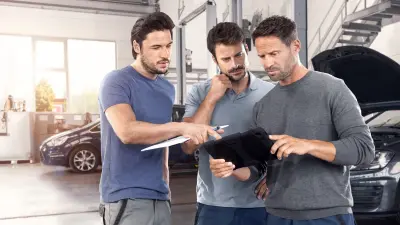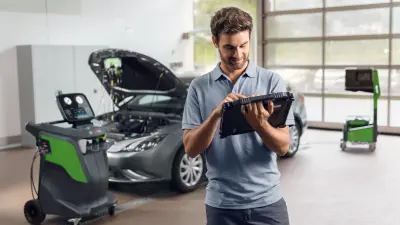Lesson 13 A demonstration of the ADAS calibration features of ESI[tronic]
Welcome to the thirteenth part of our regular workshop guides, created to help you maximize the technical potential of your Bosch ESI[tronic]. Each instalment will support you to get the tools and technical know-how you need to become an ESI[tronic] expert.
Last time, we explored the specialist support available for workshops dealing with truck and off-highway vehicles. Today we will look at ADAS systems and how your ESI[tronic] can be an integral part of facilitating dynamic and static calibration of ADAS across a wide range of vehicles.
Welcome to the world of Advanced Driver Assistance Systems (ADAS)
At this point in time, ADAS are vitally important in today’s modern-day safety systems. But they are about to get even more so – both for drivers, and for the modern-day car manufacturer.
Since 2014, all new cars have had to be sold with electronic stability programs [ESPs]. These programs support the driver in nearly all critical driving situations, by detecting vehicle skidding movements, and actively counteracting them.
Looking forward to 2024, it will become a EU legal requirement * to equip all new passenger cars introduced on the road with certain ADAS functionalities – which includes Adaptive Cruise Control, emergency braking and lane assist systems. This legal obligation has already been in place since May 2022 for all new car model homologations. ADAS will no longer be reserved for high-class or mid-class vehicles – it will become applicable to all vehicle models on the road.
So what does this mean for workshops and garages? Well, as more vehicles are built with ADAS as standard, so more of these will start coming through the doors needing repairs. Sooner or later, every workshop will need to recalibrate ADAS. And now’s your chance to get ahead of the game.
Make your workshop fit for the future

ADAS are mainly based on radar and camera sensors, working at the front and rear of vehicles to help keep the driver safe – from emergency brake assist at the front, to blind spot detection and parking at the rear. Even routine jobs like windscreen replacements often now require system recalibrations, due to the fact the sensor sits behind the windscreen (see Fig 1).
There are a few other cases when the ADAS calibration is needed:
- After wheel alignment (the steering angle sensor will need resetting and the radar and camera recalibrating)
- After any kind of work or adjustments to the chassis, steering system or suspension(e.g. shock absorber replacement)
- After accident / body collision (even small ones count)
- In the case of non-optimal functioning (e.g. customer complaints or troubleshooting)
- After a service or repair.
This means that many workshops are in fact already facing changes to the way they work, as recalibrating sensors becomes part of the job.
There are two types of calibration procedures, both of which are supported by our technical systems:

1.Dynamic (drive cycle).
This is done by driving the car in specific circumstances – preferably on a straight road with minimal turns, and above a certain speed. A diagnostic scan test is needed, and the test needs to be triggered with a diagnostic tool such as a KTS (see fig 2 & 3).
- Bosch equipment required: ESI[tronic] and a KTS diagnostic device.

2.Static:
This requires specialised equipment – a static calibration tool such as the DAS 3000. A target board (for camera sensors) or mirror (for radar sensors) is used with the diagnostic tool in precise locations around the car to perform the recalibration. You must also have a flat surface (floor or lift suitable for wheel alignment) with enough free space around the car to set up the calibration tool (see fig 4, 5 & 6).
- Bosch equipment required: The DAS 3000universal calibration tool, ESI[tronic]and a KTS diagnostic device.

It is worth noting that the type of calibration differs between car manufacturers and that a combination of static and dynamic calibrations are possible. For example, BMW use a dynamic procedure for camera calibration and a static procedure for radar calibration, whereas VW uses static calibration.

For many cars requiring just a dynamic calibration, you only need a KTS and ESI[tronic] to get the job done. But for at least half of the hypothetical car park, you will also need a static calibration device such as the DAS 3000. The good news is that you’re in safe hands with the ESI[tronic], as it gives you a clear indication about which type of calibration is needed, as well as guidingyou through the procedure.

At the end of each calibration there is the option to save the report, something that’s crucial to prove your procedure is compliant with the manufacturer’s guidelines.
Today’s technology can protect the cars of tomorrow
The ADAS trend is only going to become more firmly established as the car manufactures of today begin to make the move towards a self-drive future. And Bosch have been accompanying this trend from the beginning, with necessary solutions that can be tweaked and adapted over time. Both the ESI[tronic] and DAS3000 are future facing systems, with the software being continuously updated in line with new developments.
As one of the leading developers and suppliers of ADAS systems and components – and a market leader in ADAS research and development – we know how to treat and work with these systems. We are on hand as a reliable partner, supporting garages as they make ADAS part of their day-to-day processes.
And while many other suppliers offer ADAS calibration functionalities as an add-on, or make it available as part of their more expensive software packages, the Bosch ESI[tronic] supports both static and dynamic ADAS calibration routines in even the starting level Diagnostic package. So you can be sure that, along with the KTS and ESI[tronic], your workshop is perfectly equipped for this new service activity.
Get ready to open up a world of new possibilities in your workshop, with ADAS calibration, the new and fast-growing field of activity in the automotive space.
What to read next?
Lesson 14: The Hybrid and Electric Vehicle Capabilities of ESI[tronic]
Join us for our next lesson to learn more about how the ESI[tronic] can also help future-proof your workshop, by enabling you to work safely and efficiently with hybrid and electric vehicles.


